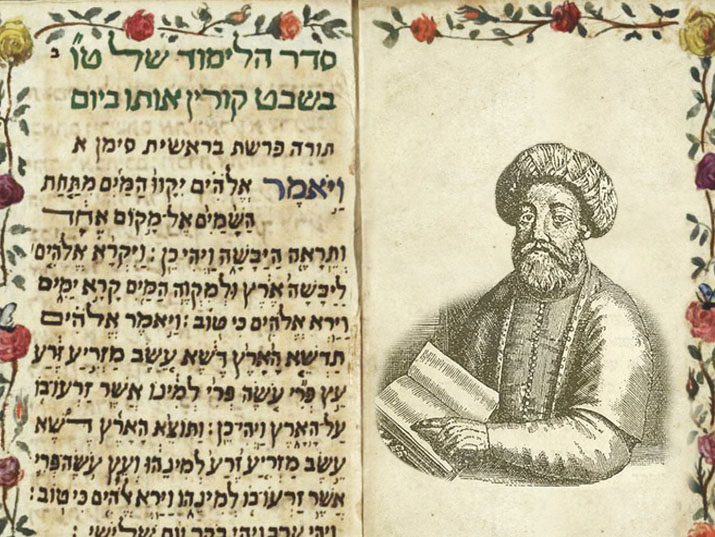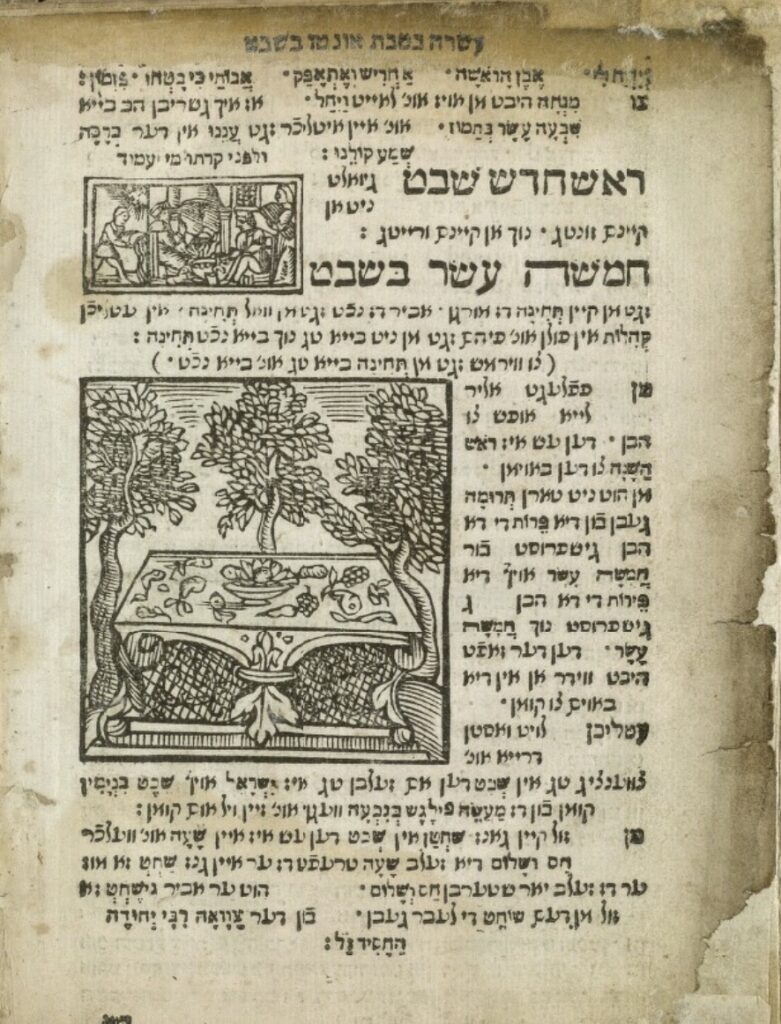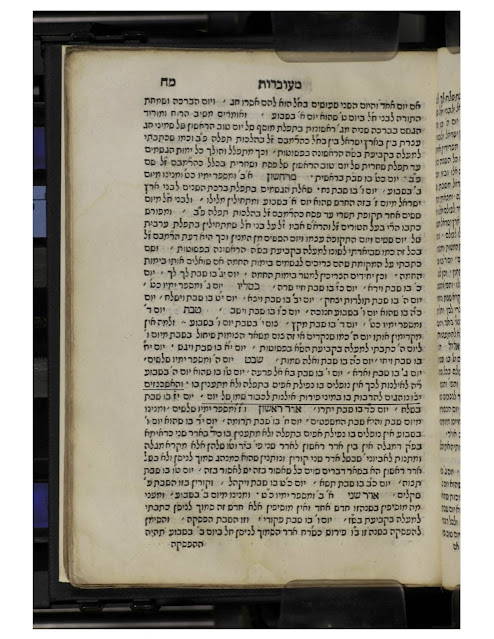Is there a rotten apple in the Tu-BeShevat Fruit Basket?
Is there a rotten apple in the Tu-BeShevat Fruit Basket?
By Dan Rabinowitz and Eliezer Brodt
[This post is heavily updated from an earlier Seforim Blog post – here]
Some claim that the origins of the custom to celebrate Tu-beShevat as a holiday that includes eating fruits and other rituals, is Sabbatean. In the main, this assertion is based upon identifying the work Hemdat Yamim as the source for Tu-beShevat as a holiday and eating fruit and other rituals. Thus, an article in Ha’aretz trumpets, “The New Year for the Trees, Isn’t it for Sabbatai Zvi.” And the National Library of Israel’s blog includes a post “The Holiday of Tu-beShevat is an Auspicious Time to Pray for the Only (?!) Jewish False Messiah.” They even include this photoshopped image.

However, a closer look at the history reveals, that although some of the customs on Tu-beShevat can be traced to Hemdat Yamim the actual celebration dates much earlier. Contrary to the popular song, Tu-beShevat hegihu hag ha-ilannot, the 15th of Shevat was not a “chag” of the trees. Instead, the earliest discussions regarding Tu-beShevat do not mention any holiday associated with the day. The first Mishna in Rosh Hashana, identifies the 15th of Shevat as the new year for trees. This designation merely defines how to calculate annualized tithes and is otherwise silent as to the significance of the date. One can’t tithe fruits from one year using a different year’s fruits. Thus the 15th of Shevat is the cut-off point. [For other contemporaneous examples see Safrai, Mishnat Erets Yisrael, Mesekhet Rosh HaShana (Jerusalem: Mehlelet Lifshitz, 2011), 305-06]. It was not until R. Gershom’s time that there were any of the traditional holiday markers, but only that fasting is prohibited.
The first mention of the custom to eat fruit and other holiday rituals appears in 16th century Machzor, published between 1548 and 1550.
That Machzor follows the Ashkenazi rite and includes a discussion of customs according to that rite and the commentary of R. Benyamin ha-Levi Ashkenazi, Ma’aglei Tzedek. He was the rabbi of the Ashkenazi community in Saloniki (of contemporary interest is that he records the death of four of his sons during a plague). This source, however, was not well-known, and, historically, a different, later, source is identified. For example, Avraham Ya’ari in his otherwise comprehensive article claims that R. Issachar ibn Susan (c. 1510-1580) is the first mention. Susan, in his Ibur Shanim, published in 1578, provides that “the Ashkenazim have the custom [on Tu-beShevat] to eat many fruits in honor of the day,” confirming the custom recorded in the Machzor. 1578 was the first authorized printing of R. Susan’s work but not the first time this custom is associated with him. In 1564, Shlomo Rie published Susan’s Tikkun Yissachar. (Ibur Shanim 48b and Tikkun Yissachar 62a). Susan, in Ibur Shanim, accuses Rie of publishing an unauthorized edition, one that contains errors and unacknowledged additions by Rie. Ibur Shanim includes a corrected and otherwise only slightly modified version of Tikkun Yissachar. [See Susan’s introduction; see also Yaakov Shmuel Spiegal, Amudim be-Tolodot Sefer ha-Ivri: Hadar Mechaber (Jerusalem, 2018), 321-22.]
Mention of this custom also appeared in a Judeo-German Minhagim book first published in 1590. “The custom is to eat many fruits as it is the New Year of the trees.”

In the community of Worms, there was a rather interesting variation of the custom. As R. Jousep Schammes (1604-1678) in his custom-book states:
On Purim and the 15 of Av and Shevat these were vacation days for the Rabbis, . . . [on the 15th of Shevat] one says tehina even during the morning prayer. It is a vacation day for the students and the teachers, especially the younger students, it is a day of feasting and joy for or the teachers and their students. The custom is for the teachers to distribute whiskey to the students and make merry with them.” Minhagei [de-Kehilah Kedosha] Vermisai le-Rebi Joszpa Shamesh (Jerusalem: Machon Yerushalim, 1988), 249-50, no. 211.
The first mention of Tu-beShevat in a Sefardic source appears in R. Hayyim Benveniste’s (1603-1673) Kenneset ha-Gedolah, first published in Livorno in 1658, where he quotes Susan from the Tikkun Yissachar. Although Benveniste would later be associated with the Sabbatian movement, his inclusion of this custom in 1658, long pre-dates the movement. Benveniste’s source does not include a seder, nor does it testify to any adoption amongst Sefardim.
Kabbalah first enters the picture in 1728 with a somewhat obscure source. In 1728, Eliyahu Malhlenov published, Birkat Eliyahu, his commentary on the Talmud. Amongst his papers,, he had a few pages of materials from R. Moshe Hagiz and appended those to Birkat Eliyahu. These materials include responsa and discussions regarding customs. Hagiz records a custom from his grandfather, R. Moshe Galante. R. Galante was also Hagiz’s teacher as his father died when Hagiz was a boy. According to Hagiz, his grandfather had “the custom that on the 15th of Shevat he would eat many fruits that required many blessings and prayed to God that he should decree for us and them a good year. He ate the following 15 fruits, and on each one would recite … a chapter of Mishna…” Hagiz then provides the order to eat the fruits.
Hagiz might technically be the first to describe a specific ceremony associated with eating fruits, but the source that popularized Tu-beShevat amongst Sefardim, and that incorporated a seder is Hemdat Yamim. Hemdat Yamim, first published in 1732 anonymously has the entire seder for Tu-beShevat. This includes passages from the Bible as well as specific foods. This in turn was popularized to a greater degree when it was included in the book Pri Etz Hadar first published in 1753 and republished an additional 29 times by 1959, and now digitized on Sefaria.
The author of Hemdat Yamim concedes that this is not a custom that originated with the Ari or his students. Nonetheless, the author provides his own kabbalistic ideas and wrote his own kabbalistic prayers for the occasion, and a specific order to the ceremony. According to many scholars, Hemdat Yamim is not reflective of the kabbalah of the Ari but that of Sabbatai Tzvi and his disciples. Indeed, Boaz Huss has identified specific prayers in the Hemdat Yamim Tu-beShevat liturgy that allude to Sabbatai Tzvi. Whether or not this assertion is correct, because we can trace this custom, that of eating fruits, to over 100 years prior to the Sabbatian movement as already a pre-existing custom, it is likely unrelated to Sabbatian theology or custom.
Plagiarism
Avraham Ya’ari, the noted bibliographer, wrote a comprehensive article tracing the history of Tu-beShevat. That article appeared in Machanim and is available at Daat. This article, at times entire paragraphs, are reprinted verbatim, without any attribution, in a recent book ostensibly authored by Tuvia Freund, Moadim le-Simchah. Published in six volumes between 1998-2010, this work is replete with such examples of plagiarism. Here, however, Freund did something arguably even more egregious. In the pages of materials he steals, Freund cites Yaari and his article by name. Not for the fact that all the above material comes from there but a small tangential item, the number of times a book was printed. Indeed, Freund is so unwilling to give Yaari any credit in a paragraph lifted word for word from Yaari, the work Hemdet Yamim is discussed. Freund provides in a footnote, “see the long discussion regarding this work in Sefer Talmumot Sefer page 134 and on.” Freund doesn’t reveal the author of Talmumot Sefer, who is none other than Yaari. Freund doubly removed Yaari from the picture.
Magen Avraham
The Magen Avraham cites the Tikkun Yissachar as the earliest source for the custom to eat fruits on the 15th of Shevat. This, despite the fact that he had accessed, and indeed quotes on many occasions, the Machzor with the Maageli Tzedek commentary. See, e.g.,
נה:יז, פח:ג, קלא:י, תכז:א, תלא:ה, תלז:יז, תכז:א, תנ:יב, תנג:יא, תקפא:ד, תקפא:ז, תקפא:ח, תקפב:ח, תקפג:ב תקפד:ג, תקפט:ד, תרכד:ז, תרכט:ה, תרנא:יט, תרנא:כא, תרנח:יב, תרסא:, תרע:ב [2X], תרעב:ה, תרעג:ז, תרפא:א, תרפח:יא, תרצ:יט, תרצא:ח
While he had access to the Machzor, he did not have access to the Tikkun Yissachar. The Magen Avraham quotes the Tikkun Yissachar on a few occasions, but always via a secondary source. See Brodt Halachic Commentaries to the Shulchan Aruch on Orach Chayim from Ashkenaz and Poland in the Seventeenth Century (PHD Bar Ilan 2015), pp. 68-69. The Mekor Chaim in O.C. 686:1 is the first to point to the Machzor for this minhag.
The halachot in the Machzor were collected by Yitzhak Hershkowitz ed., Maglei Tzedek (Jerusalem, 2000), pp. 156-157. Regarding R. Benyamin see Y.S. Emmanuel, Matsavos Saloniki, vol. 1 (Jerusalem, 1973), 36, 68-69; Meir Benayahu, “Rebi Shmuel Yaffa Ashkenazi,” in Tarbiz, 42 (1973), 423-24 and note 37; M.S. Molcho, Matsevot Bet ha-Olamin she Yehudi Saloniki (Tel Aviv, 1975), 59-60; Yitzhak Rivkin, “Dikdukei Soferim,” in Kiryat Sefer 4 (1927), 278 no. 32; Daniel Goldschmidt, Mehkerei Tefillah u-Piyyut, 252-65, Meir Benayahu, Defus ha-Ivri be-Kremonah (Jerusalem, 1971), 141-78. About Knesset Hagedolah and being a Sabbatean see Brodt, Halachic Commentaries to the Shulchan Aruch on Orach Chayim from Ashkenaz and Poland in the Seventeenth Century, pp. 56; Brodt, Yeshurun 35 ( 2016 )p. 775; See also the recent work, R. Shmuel Ashkenazi, Igrot Shmuel (2021)-, 1, pp. 4-5.
R. Shmuel Ashkenazi
As the Seforim Blog just published Iggrot Shmuel from R. Shmuel Ashkenazi (see here and here) we reprint two letters from his collection, one discussing the origins of the holiday of the 15th of Shevat and the other Hemdat Yamim.
Notes:
Additional sources discussing the 15th of Shevat, see Meir Rafeld, Netivi Meir, (2013), 185-189; R Mandelbaum, Tehilah Ledovid (Jerusalem, 1993); Guttman, Otzar TuBeshvat.
Tikkun Yissachar was republished in 1988 with an excellent introduction from R. Betzalel Landau. Most recently, in 2019, it was reprinted and re-typeset, with additional notes. This edition also includes R Landau’s introduction and another introduction of material about the work. See also Elisheva Carlebach, Palaces of Time: Jewish Calendar and Culture in Early Modern Europe (London: Belknap, 2011), 51-58; יוסף הקר, ‘יששכר אבן סוסאן עליית כוהנים לתורה בשמחת חתנים’, בתוך: ‘מנחה למנחם’, קובץ מאמרים לכבוד ר’ מנחם כהן, בעריכת חנה עמית, אביעד כהן וחיים באר, ירושלים תשס”ח, עמ’ 79-97
Regarding Hagiz, see Elisheva Carlebach, The Pursuit of Heresy (New York: Columbia University Press, 1990).
After the Birkat Eliyahu was published it was attacked by some rabbis. See Meir Benayahu, “Sefarim she-Hiburum R. Moshe Hagiz she-Hotsyim le-Or,” in Ali Sefer 4 (1977), 143, 150-52; see also Shlomo Yaakovovitch, “Sefer Shehitot u-Bedikot le-R’ Yaakov Weil,” in Tsefunot 4 (1989), 112; Carlebach, Pursuit of Heresy, 247-49. Regarding R. Eliyahu see Y. Halpern, Pinkas Vaad Arba Arotsot (Jerusalem, 1990) 362; Tzvi Horowitz, Le-Tolodot ha-Kehilot be-Polin (Jerusalem, 1989), 1.
The literature on Hemdat Yamim is substantial and we hope to return to the work in an upcoming post. For the most recent discussion see Y. Goldhaber, “Le-Birur Zehuto shel Mehaber Hemdat Yamim,” in Sefer Zikhoron le-Professor Meir Benayahu, vol. 2 (Jerusalem: Karmel, 2019), 873-908.
Huss’s article appears as Boaz Huss, “Ha-Ets ha-Nehmad ben Yishi Hayi al ha-Adama: al Mekoro ha-Sabbatai shel Seder 15 Shevat,” in Sefer Zikhoron le-Professor Meir Benayahu, vol. 2 (Jerusalem: Karmel, 2019), 909-20.













3 thoughts on “Is there a rotten apple in the Tu-BeShevat Fruit Basket?”
I think it’s pretty well accepted by most scholars these days that the Hemdat Yamim is pretty much a collection of material found in earlier sources, with little original material. (This complicates the question of whether the author himself was a Sabbatean, since his inclusion of material from Sabbatean sources may have been inadvertent or based on an assessment that these particular items were not objectionable.) As related to the issue at hand, the implication is that even if something is ostensibly sourced to the HY, you need to track down the original source before deciding on how authoritative it is.
It’s a huge mistake (& completely inappropriate) to say “Although Benveniste would later be associated with the Sabbatian movement …” in the context of the discussion here. R’ Benveniste was probably the most prominent person who mistakenly thought that SZ was moshiach. But he did not remain part of the movement after SZ converted, and he was not associated with the new (& generally heretical) Sabbatean kabbala which was formulated to justify an apostate moshiach. Something which was cited by R’ Benveniste, whether before or after SZ, is as authoritative as something cited by any other posek, and is not tainted by being “Sabbatean”.
Kudos to Dan and Eliezer for setting the record straight. As for the “some claim” whom they’re refuting, perhaps the best epitaph for them was given by R. Chaim Liberman (Ohel Rachel, p. 2):
זכורני זו היתה שיטת המשטרה בארץ מולדתי: הכל היו בחזקת חשודים. והפקודה לשוטרים היתה: ״סחוב למשטרה. שם יבררו״.
Can you provide the original text of the Minhagei Worms? Thanks